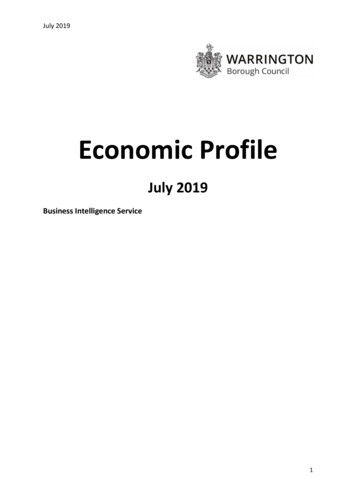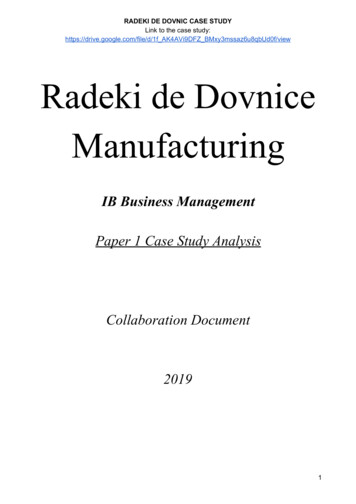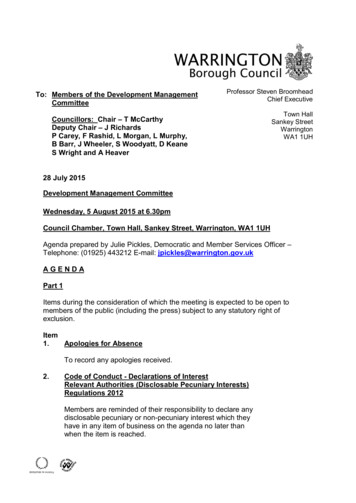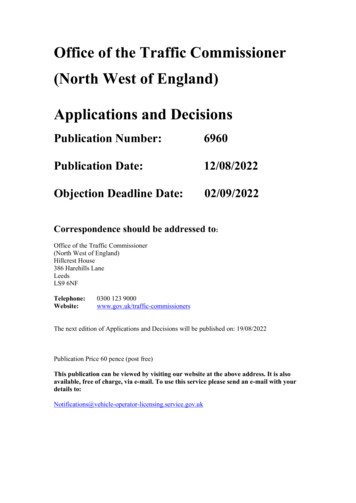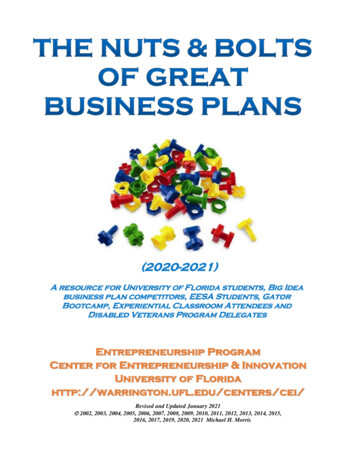
Transcription
(2020-2021)A resource for University of Florida students, Big Ideabusiness plan competitors, EESA Students, GatorBootcamp, Experiential Classroom Attendees andDisabled Veterans Program DelegatesEntrepreneurship ProgramCenter for Entrepreneurship & InnovationUniversity of ed and Updated January 2021 2002, 2003, 2004, 2005, 2006, 2007, 2008, 2009, 2010, 2011, 2012, 2013, 2014, 2015,2016, 2017, 2019, 2020, 2021 Michael H. Morris
1Table of ContentsPageA Note on Your Overall Approach3The Plan is Worthless if You Don’t Do the Research:Some Helpful Tips4Note for Those Planning Social Ventures4Required Structure: An Outline of Your Business Plan5Suggested Length for the Sections of Your Plan7Formatting and Use of Tables and Figures7Breakdown of the Major Sections of Your Business Plan8Covering Your Bases: Forty Issues to Die For26Sample Rating Sheet Used by Judges: Written Plan28Sample Rating Sheet Used by Judges: Oral Presentation29IMAGINE BELIEVE CREATE
2“Plans are nothing---planning iseverything.”Dwight D. Eisenhower“The business plan is an innovationplatform. It allows you to experiment andadapt until you have something that canwork. It brings discipline to your creativevision---write it for yourself---and use itto see what works and what has to bechanged”Prof. M. MorrisIMAGINE BELIEVE CREATE
3A NOTE ON YOUR OVERALL APPROACH A business plan is where imagination meets discipline A business plan is not a checklist, where you address sections one by one. It is a living,breathing document. You are telling a story, and bringing a venture to life. It is about acompany, not a product or an idea. It is about how that company can become a viable ongoingentity. A viable company has many facets, and these are reflected in the various sections of theplan. Most critically, the sections are highly interdependent. They must be internally consistentand “hang together”. As you subsequently make changes to one section, you will find yourselfhaving to go back and make adjustments to a number of other sections.Your ideas have flaws. It is the discipline of the plan that will help you see critical flaws in youridea, in your target market, how you plan to price, your cost requirements, your operationalapproach, your marketing methods, and so forth. And no matter what you think, there arecritical flaws. You will have to continually adapt as you learn more about this business and theindustry within which it will operate. Using the plan as a framework, it will help you to ‘tweak’or adjust aspects of what you propose to do in ways that make the venture more viable.A business plan is also an objective and fact-based document. Address the upside and thedownside. Make clear you understand what can go wrong. Be conservative. And importantly,the plan is not written in first person, so be sure to eliminate all use of ‘I’, ‘We’, ‘Our’, and ‘Us’.Use your company name to refer to the business.It is critical that you organize your team (or yourself if doing it alone) in a logical fashion. If youdivide sections among team members, some sections require multiple people or a lot more effortfor a number of weeks, others might only require a single person and can be accomplished in ashorter time period. Complete the financials last, but finish the economics fairly early in theprocess. The market section will be the hardest and take the longest. You should start on it rightaway. A logical approach is to break the overall plan down into THREE STAGES. First, attack four key sections: the Industry, the Company/Concept/Products, the Market,and Economics (think of this as stage one); These sections will lay out the nature of theopportunity and how you are going to capitalize on it;Then, go after the Marketing, Design and Development, Operations, and ManagementTeam sections (stage two); These sections really get at the nitty-gritty of how you willmake things operational;Finally, address the Risks and Assumptions, Timetable, Financials and the Offering orDeal (stage three). Here you focus on implementation, what can go wrong, how thebusiness will perform, and how much money is needed.Be sure that you have someone assigned to ensure the internal consistency among sections in thefinal document.Ultimately, write the plan for yourself, not for a course, an instructor, or a competition. It will bean invaluable part of your professional portfolio, and will give you a skill set that you can use forthe rest of your professional life. You will refer back to it more often than you might think nomatter whether you start your venture.IMAGINE BELIEVE CREATE
4THE PLAN IS WORTHLESS IF YOU DON’T DO THERESEARCH: Some Helpful TipsThe best plans are always ones where the entrepreneur or team gathers the best information, doesthe most library & secondary research, the most extensive field research, and digs deeply. Betterinformation helps you justify positions, ensures you have anticipated the challenges (a realitycheck), and is a source of creative inspiration---when you uncover approaches being used byothers. Many answers you seek are hard to find, don’t exist in one place, and must be piecedtogether. Research for a great plan is truly a “scavenger hunt”. We have prepared two excellentresources that address where to find key facts, figures and insights. Many sources, but certainlynot all, are available electronically. The websites below are beginning points for your ceiIf you limit your search to looking on the web through Google or some other search engine, youwill miss much of the best research that will support your venture. In addition to the sitesabove, it is vital that you use the library and do a search using ABI-Inform (on UF website, clickResearch, then Library, then Databases, then Business and Management, then ABI-Inform. Thenenter key words that relate to your venture. There are many rich information sources, fromMintel Reports and IBISWorld to government publications such as County Business Patterns.The librarians can be extremely helpful. You are especially encouraged to seek help from thebusiness librarian. It is also vital that you get out in the field and talk to suppliers, tradeassociations, customers, competitors, and potential investors. They will open your eyes tothings that you simply had not considered. Remember that a business plan is not a term paper, soreferences should be used sparingly, but are needed to support claims. A section called‘references’ or ‘key sources’ must appear at the back of the plan. Always provide citations forkey numbers or research that support your case. When conducting interviews, cite the date andplace of the interview in your ‘references’ section.NOTE FOR THOSE PLANNING SOCIAL VENTURESIf you are planning to launch a social or non-profit venture, sections of your plan will vary a bitfrom what follows. Even if there is not a revenue generating aspect of your venture, you shouldinclude discussion of income streams and social return on investment. Here are some resources:Stanford's Social Business Model Canvas: https://sehub.stanford.edu/pro-1Stanford’s Social Venture Funding Resources: https://sehub.stanford.edu/pro-3Stanford’s Social Venture Legal Structures: https://sehub.stanford.edu/pro-4GSV Social Impact Assessment: es/Measuring SROI: ntact Dr. Kristin Joos, coordinator of CEI's Social Entrepreneurship & Sustainability Initiative(kristin.joos@warrington.ufl.edu), for more information on social ventures.IMAGINE BELIEVE CREATE
5REQUIRED STRUCTURE:AN OUTLINE OF YOUR BUSINESS PLANEXECUTIVE SUMMARY Opportunity Statement Business Concept and Product or Service Description of the Target Market Competitive Advantage Essence of Marketing Approach Economics and Breakeven Technology and Operational Issues The Team Financial Highlights Financing Needs and How the Entrepreneur or Team Proposes to Raise the MoneyI.II.III.IV.V.THE INDUSTRYA. Define Industry, Its Size and Growth RateB. Industry StructureC. Industry TrendsD. Key Success FactorsTHE COMPANY, CONCEPT AND PRODUCT(S) OR SERVICE(S)A.The CompanyB.The ConceptC.The Product(s) or Services(s)D.Entry and Growth StrategyMARKET ANALYSISA. Definition of Your Relevant MarketB. Market Size and TrendsC. Buyer Demographics and Buyer BehaviorD. Market Segmentation and TargetingE. Competition and Competitive EdgesF. Estimated Market Share and Sales FiguresG. Ongoing Market EvaluationTHE ECONOMICS OF THE BUSINESSA. Revenue Sources and MarginsB. Fixed and Variable CostsC. Operating Leverage and its ImplicationsD. Start-up CostsE. Breakeven Chart and CalculationF. Overall Economic Model : Logic of ProfitG. Profit Potential and DurabilityTHE MARKETING PLANA. Overall Marketing StrategyB. PricingC. The Selling CycleD. Sales TacticsE. Advertising and Sales PromotionsF. PublicityG. Customer ServiceIMAGINE BELIEVE CREATE
6H. Warranty or Guarantee PoliciesI. DistributionVI.VII.VIII.IX.X.XI.XII.XIII.DESIGN AND DEVELOPMENT PLAN (also called R&D)A. Development Status and TasksB. Difficulties and RisksC. Product Improvement and New ProductsD. Projected Development CostsE. Proprietary Issues/Intellectual Property (patents, licenses, copyrights, brand names, trade secrets)OPERATIONS PLANA. Operations StrategyB. Operating Model and Cycle (front stage and back stage)C. Geographic Location and Physical Location RequirementsD. Facilities and ImprovementsE. Equipment RequirementsF. Employee (non-managerial) RequirementsG. Capacity Levels and Inventory ManagementH. Legal Issues Affecting OperationsMANAGEMENT TEAMA. Key Management Personnel and ResponsibilitiesB. Organization StructureC. Management Compensation and OwnershipD. Other Partners and Current InvestorsE. Employment and Other Agreements, Stock Option and Bonus PlansF. Board of DirectorsG. Other Shareholders, Rights, and RestrictionsH. Supporting Professional Advisors and ServicesOVERALL SCHEDULECRITICAL RISKS, PROBLEMS, AND ASSUMPTIONSFINANCIAL PLAN (3 - 5 years of statements go in appendix)A. Highlights of the Financial StatementsB. Months to Breakeven and to Positive Cash FlowC. Key Financial Assumptions (unless covered in preceding section)D. Key Cost ControlsE. Pro Forma Income StatementsF. Pro Forma Balance SheetsG. Pro Forma Cash Flow AnalysisPROPOSED COMPANY OFFERINGA. Desired Financing (money needed)B. Proposed OfferingC. CapitalizationD. Use of FundsE. Investor’s ReturnAPPENDICES (including one on key sources used/references)IMAGINE BELIEVE CREATE
7SUGGESTED LENGTH FOR THE SECTIONS OF YOUR PLANBelow are some general guidelines for the length of the key sections of your business plan afteryou have done final editing and streamlining:Table of Contents (1 page)Executive Summary (2 pages)Industry (2-3 pages)Company, Concept and Products/Services (2-3 pages)Market Analysis (3-5 pages)Economics of the Business (2-3 pages)Marketing and Communications Strategy (2-4 pages)Design and Development (2 pages)Operations Plan (2-4 pages)Management Team (1-2 pages)Risk and Assumptions (1-2 pages)Timeline/Schedule (1-2 pages)Financial Projections & Highlights (1-2 pages) (financial statements go in the appendix)Offering or Proposed Deal Structure (1 page)Appendices (no more than 15 pages)Please note: As a general rule, plans are much longer with the first draft, and then are editeddown to a content-rich but streamlined final version. Page length is determined by the audiencefor the plan, but generally ranges from 25-35 pages, excluding appendices. For the UF Big IdeasCompetition, plans should not exceed 35 pages plus 15 pages of appendices (total of 50 pages).Plans over 60 pages will not be read (at least past page 60).FORMATTING AND USE OF TABLES AND FIGURESIt is generally expected that you will use one inch margins on all sides, and a 12 font. Anythingless than an 11 font is not acceptable. Spacing is up to you; single spacing can be used, but plansare typically either double-spaced or 1.5 spaced. You should cite key references in the text usingthe following notation in parenthesis at the end of the sentence from which the citation is taken:(author, year). Thus you will put (Jones, 2012) if Jones is the author. If there is no author, youwill put the source and the date, as in: (U.S. Department of Commerce, 2011). If a direct quote,cite the page number, as in (Jones, 2012, p. 45). There then should be a complete set ofreferences at the end of the plan.Bring the plan alive. One of the worst things you can do is to write a plan that consists of pageafter page of unbroken text. Use headings, sub-headings, and sub-sub-heading to break up thetext. Just as critically, use tables and figures (exhibits) to break up the text, to illustrate keypoints, and to bring the plan to life. It is often possible to significantly shorten the text in a givensection by using a couple of tables and figures. A picture or diagram can tell a vivid story. Besure every table and figure is numbered, titled, and referred to in the text.IMAGINE BELIEVE CREATE
8BREAKDOWN OF THE MAJOR SECTIONS OF YOURBUSINESS PLANTHE EXECUTIVE SUMMARY (2 pages max)Although this is the first section of the plan, the Executive Summary is the last section that you write. TheExecutive Summary concisely summarizes the essence of the business and the key decisions made bythe entrepreneurial team in ten key areas from your plan. It is not merely an abbreviated businessplan. The reader should get a clear, basic picture of the business, and be enticed to want to read more.Many entrepreneurs or teams fail to consider adequately their markets, their customers and a businessmodel that will enable them to achieve success. Instead they often get wrapped up in an interestingtechnology or product, which is not the same thing as an attractive business. The questions below willhelp you focus on the aspects of your executive summary that are relevant to the business plan. These aresome initial considerations that first time readers (venture capitalists, banks, business plan judges, etc.)look at before going on to evaluate the members of the team and the soundness of your financialprojections. Make sure that your executive summary provides answers to these questions in addition togiving the reader an overview of the highlights from your business plan for the new venture.Opportunity Statement: What is the nature and size of the opportunity or problem? (the underlying need )What forces are creating the opportunity?Why is the opportunity now?Business Concept and Product or Service: How would you describe the business to a potential investor, team member, or customer if youhad only a short elevator ride to share together? Make sure you have a succinct and powerful wayto express your business concept.What is unique about this venture?Develop a brief concept statement for the product or service that can be shown to potentialcustomers.How will the product be used? What are some unique features? What existing problem(s) willyou solve with your service or product offering? What are the primary benefits to customers?How does your solution improve or replace current offerings?Competitive Advantage: What special knowledge or technology do you possess and how will you protect it?What are the barriers to entry? Who will the competitors be?How will your service or product compare to those of your competitors in terms of usefulness,cost, styling, ergonomics, time-to-market, strategic alliances, technological innovations,compatibility with related product, etc?Description of the Target Market:IMAGINE BELIEVE CREATE
9 Briefly define your relevant market.What is the current size and expected growth of your target market?What segments will you be targeting?Who will your first customer(s) be?What proof can you offer that your target customers will value your product or service?Essence of Marketing Approach What do you need to do very well in order to win this market?Indicate the key marketing methods used to accomplish salesSummarize your pricing position relative to the rest of the industrySummary the distribution channel approachTechnology and Operational Issues: What technology will you employ?Where are you in terms of R&D on the products/services?Will production be handled by you or outsourced?What is unique about your approach to production or operations?The Team: Who are you and why can you do this?Briefly summarize your team’s qualifications.Economics: What are the firm’s margins and volumes?Is the cost structure more fixed or variable?Make clear the model for making money.Financial Highlights: When will breakeven be achieved?What is the level of potential sales of your product or service?What level of profits do you expect to achieve?Financial Need: How much money are you requesting?From what sources are you looking for money and in exchange for what (e.g., how much equity)?What the rate of return investors will receive and when will they receive their return?IMAGINE BELIEVE CREATE
10GENERAL NOTE: From here onwards, we cover everything that could go into each section ofthe plan in a perfect world. As the sections are written to describe any and all types of ventures,some issues may not fit your plan, and others may be more complex given the data and resourcesyou have at hand. Nonetheless, do your best to address all the issues that apply.SECTION I: THE INDUSTRYThe “industry” refers to the larger landscape, as in the “computer hardware wholesale industry” or the “card and giftretail industry” or the “architectural services industry”. The focus here is on what is happening in, and the relativeattractiveness of, the industry as a whole. You are looking at the entire industry in the U.S. or globally. As such, thissection does not involve any description of your company or your local market. This section needs to include thefollowing information: Summarize the industry in which the proposed business will operate. Give the relevant SIC / NAICS codefor the industry. What are the key components of segments of the industry?Discuss briefly industry size (in dollars) and annual growth rate (%); Where is the industry in its life cycle--emerging, early growth, rapid growth, early maturity, maturity, decline?Discuss the structure of the industry at present. How concentrated or fragmented is the industry? Howmany players are there, and how many are large versus small? Who are the largest and most importantplayers in the industry? Outline Porter’s 5 forces (barriers to entry, bargaining power of suppliers,bargaining power of distributors and customers, effective substitutes and intensity of competitive rivalry)and draw conclusions. If appropriate (when there are different kinds of firms that contribute to how theindustry operates), describe the value chain.Highlight key trends in the industry. These can be found in the trade literature. Are costs going down orup? What about prices? Discuss any new products or developments, the rate of new product development,new markets and customers, new selling approaches, new pricing methods, new requirements orregulations, new entrants and exits, new technologies, and any other national or economic trends andfactors that could affect the venture’s business positively or negatively.Determine the key success factors for the industry and draw conclusions. What are the winners able to doconsistently that the losers or also-rans to not do?Find standard financial ratios for the industry and summarize key ones.SECTION II: THE COMPANY, CONCEPT, AND PRODUCT(S) OR SERVICE(S)Now the focus turns to your own venture. First outline the nature of the entity you plan to create and where you arein that process, then capture the essence of your business concept, then detail the products and services youanticipate selling, and then talk about your entry approach and your vision for growth over the next five years.A. The Company and the Concept What form will the company take (e.g., partnership, S-corporation, LLC, etc.), where will it be based, andwhen will it commence operations?Briefly summarize the company history, how the concept was discovered, as well as the current status ofthe company. Spell out the mission and main objectives of the company:Describe specifically the concept behind the business (i.e. your unique value proposition the corebenefits you will provide to a user, the need or pain you will address)B. The Product(s) or Service(s) Mix Describe each product or service you will be selling (what it is and isn’t – describe the product fully andprovide pictures or graphics if you can). Begin to sell your idea here by generating some excitement aboutyour product or service.IMAGINE BELIEVE CREATE
11 Discuss the application (what it does) of the product or service and describe the primary end use as well asany significant secondary applications (who will use it and why).Provide a diagram of the intended depth and breadth of your product/service mix and which products willlikely generate the lion’s share of the revenueEmphasize any unique features of the product or service and how these will create or add significant value;also, highlight any differences between what is currently on the market and what you will offer that willaccount for your market penetration. Be sure to describe how value will be added and the payback period tothe customer. More specifically, discuss how many months it will take for the customer to cover the initialpurchase price of the product or service as a result of its time, cost or productivity improvements. Describethe competitive strengths and how it differentiates you from competitors.Include a description of any possible drawbacks (including obsolescence or ease of someone else copyingthe product or service.Discuss any head start you might have that would enable you to achieve a favored or entrenched position inthe industry e.g. proprietary rights (patents, copyrights, trade secrets or non-compete agreements. Describethe key factors that dictate the success of your product/service. Describe any features of the product orservice that give it an “unfair” advantage over the competition e.g. proprietary knowledge or skills.Discuss any opportunities for the expansion of the product line or the development of related products orservices. Emphasize opportunities and explain how you will take advantage of them.C. Entry and Growth Strategy How and where will you initially enter the market?Share your vision for where the firm will be in five years (geographic scope, markets entered, number oflocations, expansion of product mix).Summarize how quickly you intend to grow during the first five years and your plans for growth beyondyour initial product or service.Discuss how you will create barriers to entry in terms of others copying your success.SECTION III: MARKET ANALYSIS(aka ‘THE MARKET’)This section of the business plan is one of the most difficult to prepare, yet it is arguably the most important. Othersections of the business plan depend on the market research and analysis presented here. Because of the importanceof market analysis and the critical dependence of other parts of the plan on the information, prepare this section ofthe business plan with great attention to detail. Take enough time to do this section thoroughly and check alternativesources of market data.This section should convince the reader or investor that you truly know your customers. It should convince thereader that your product or service a) will have a substantial market opportunity; and b) can achieve sales in the faceof competition. For example, the predicted sales levels directly influence such factors as the size of the productionoperation, the marketing plan, and the amount of debt and equity capital you will require. Yet most entrepreneursseem to have great difficulty preparing and presenting market research and analyses that show that their ventures’sales estimates are sound and attainable. You must talk with prospective customers. Also, consult industrypublications, trade associations, and articles in trade magazines to understand how the industry defines, identifiesand segments its customers. Then apply yourself creatively by integrating the information in a unique way.A. Definition of Your Relevant Market and Customer Overview Provide a very specific definition of your relevant market. Where will 90% of your customers come from?What are the parameters or boundaries that you are using to define the market in which you will operate?Discuss who the customers for the product(s) or service(s) are or will be. Provide general demographics forthe customer base in your defined market (note: below you will get into segmentation of this market anddescriptors of segments).IMAGINE BELIEVE CREATE
12 Make it clear if you must serve more than one market (e.g., a website that must sell both to advertisers andto customers). Include separate discussions of the issues below for each market.B. Market Size and Growth Rate: For your defined market, estimate market size and potential in dollars and units. You will need to “invent amethodology” for making these estimates based on the kinds of data you are able to fine.Note the key assumptions that your projections are based upon.If relevant, estimate the size of the primary and selective demand gaps.Describe the potential annual growth rate for at least three years of the total market for your product(s) orservice(s) for each major customer group, region, or country, as appropriate.Discuss the major factors affecting customer sales growth (e.g., changing needs, socioeconomic trends,government policy, interest rates, population shifts) and review previous trends in the market.C. Buyer Behavior: Here you want to get into who buys, when, why, where, what and how they buy.Who is the actual purchase decision-maker? Does anyone else get involved in the buying decision-process?What are the key stages or steps in the customer’s buying process and what happens in each stage?Describe customers’ purchase decision processes, including the bases on which they make buying decisions(e.g., price, quality, comfort, styles, timing, delivery, training, service, personal recommendations, politicalpressures, etc.) and why they might change from current suppliers.How long is the customer’s buying process (starting from when they have never heard of your product andending with a purchase and then a satisfactory consumption experience).Who are the major purchasers of the products or services in each market segment? Where are they located?Indicate whether this is a high, medium or low involvement purchase and draw implications.Indicate whether customers are difficult to reach and how strong their loyalties and switching costs arelikely to be toward existing solutions.Discuss interviews you have had with users of this product or service category.List any orders, contracts, or letters of commitment that you have in hand. These are the most powerful datayou can provide. List any potential customers who have expressed an interest in the product(s) or service(s)and indicate why. Indicate how quickly you believe your product or service will be accepted in the market.Which are the twenty percent of customers likely to account for eighty percent of your revenue? List anddescribe your five potentially largest customers. What percentage of your sales do they represent?In what way are customers dissatisfied with current offerings in the market place or what emergingcustomer groups are being ignored?D. Market Segmentation and Targeting Discuss how your defined market can be further broken down into specific market segments. Be creativeand insightful in describing the existing segments.Note that potential customers need to be classified by relatively homogeneous groups having commonneeds and/or buying behaviors. What characteristics define your target customers (demographics,psychographics, benefits sought, information sources utilized, product usage rate, etc.).Which segments represent the greatest sales potential?Include a table summarizing the various segments. Indicate which segments you will be prioritizing.E. Competition and Competitive EdgesIMAGINE BELIEVE CREATE
13 Identify direct and indirect (and potential) competitors. DO NOT INDICATE THAT THERE IS NOCOMPETITION. Make a realistic assessment of their strengths and weaknesses. Discuss the 3 or 4 keycompetitors and why customers buy from them, and determine why customers might leave them.Discuss the current advantages and disadvantages of competitor products and the extent to which they arenot meeting customer needs. IN A TABLE, compare also important attributes such as quality, price,performance, delivery, timing, service, warranties, and pertinent features of your product/service with thoseof competitors. Indicate who are the service, pricing, performance, cost, and quality leaders.Are there any substitute and/or alternative products/ services that compete for the same share of thecustomer’s wallet? What are they and why will be customers buy from you instead?Compare competing and substitute products or services on the basis of production cost advantages, scaleadvantages, distribution channel advantages, and resources.Compare the fundamental value that is added or created by your product or service, in terms of economicbenefits to the customer and to your competitors.Why aren’t competitors or other firms doing what you will be doing? Discuss whether competitors aresimply sluggish or non-responsive, lacking key capabilities, or are asleep at the wheel.Discuss why any companies have entered or dropped out of the market in recent years.From what you know about com
FINANCIAL PLAN (3 - 5 years of statements go in appendix) A. Highlights of the Financial Statements B. Months to Breakeven and to Positive Cash Flow C. Key Financial Assumptions (unless covered in preceding section) D. Key Cost Controls E. Pro Forma Income Statements F. Pro Forma Balance Sheets G. Pro Forma Cash Flow Analysis XII.

